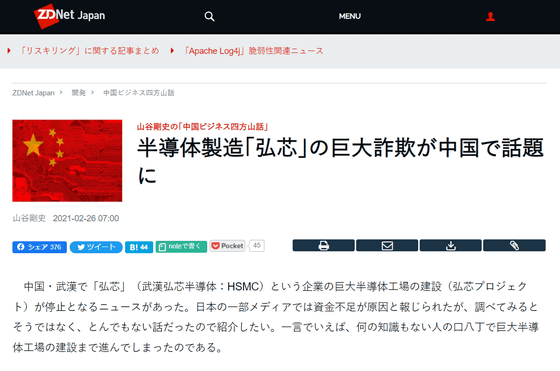Why did the Chinese government invest more than 260 billion yen in domestic semiconductor manufacturing, but all failed?

Many of the chips used in PCs and smartphones are manufactured by foundries such as TSMC in Taiwan and Samsung in South Korea. A Chinese start-up was working on a project to manufacture semiconductors equivalent to those manufactured by TSMC and Samsung with government support, but it was reported to be a complete failure. This is summarized by The Wall Street Journal.
Two Chinese Startups Tried to Catch Up to Makers of Advanced Computer Chips—and Failed --WSJ
https://www.wsj.com/articles/two-chinese-startups-tried-to-catch-up-to-makers-of-advanced-computer-chipsand-failed-11641724382/

The biggest problem for China, where the latest technology is being developed remarkably, is the manufacture of semiconductor chips necessary for everything from PCs and smartphones to home appliances and cars. The production volume of Chinese chip makers is only about 17% of the chips needed in Japan, and we have to depend on overseas makers.
In addition, the focus on semiconductor manufacturing has become an important priority for China, as trade tensions have worsened relations with the United States since the Trump administration and some companies have restricted access to chip manufacturing technology. It has become.
In late December 2021, Intel sent a letter to its suppliers requesting that it avoid procurement from the Xinjiang Uygur Autonomous Region, and was bashed by Chinese media and consumers. This also symbolizes China's reliance on foreign-made chips, the Wall Street Journal points out.
Intel faces boycott because of opposition to China's 'Uighur forced labor'-GIGAZINE

In particular, Huawei has been forced to develop its own chips, as export control from the United States has been strengthened and semiconductor procurement has been completely cut off. Huawei established an investment company in 2019, including manufacturers of machines for cleaning chip components , manufacturers of chemicals used in photolithography to transfer circuits to substrates, manufacturers of high-power laser equipment used in chip manufacturing, etc. , It seems that they are actively investing in semiconductor manufacturing related companies in China.
In addition, since around 2014, the Chinese government has been promoting an industrial support plan of 22 billion dollars (about 2.5 trillion yen) for the purpose of tip investment. Local governments have also set up similar funds. In 2019, the Second National Semiconductor Fund, worth about $ 30 billion, was established.
Tens of billions from the Chinese government to support two companies, Wuhan Hongshin Semiconductor Manufacturing Co., Ltd. (HSMC) and Izumishin Integrated Circuit Manufacturing (Jinan) Co., Ltd. (QXIC) , which were promoting the project in question. He said he received a yen investment.
The HSMC and QXIC projects started with the manufacturing process of 14nm or less, which TSMC and Samsung are good at, and aimed to move to the 7nm process within a few years. HSMC welcomed a former TSMC executive as CEO, and QXIC hired experienced engineers from various semiconductor companies, including TSMC, and paid a large amount of compensation.
China pulls more than 100 engineers a year from Taiwanese semiconductor manufacturers-GIGAZINE

However, the local government of Wuhan City announced that the HSMC project was suspended due to financial difficulties, and the project itself was officially abolished in June 2021. However, there is also the following point that HSMC was originally not a track record as a semiconductor company, and the project itself was a fraud to skillfully draw a huge investment from the Wuhan government, which has little understanding of the semiconductor business. ..
Giant fraud of semiconductor manufacturing 'Hiroshin' is talked about in China --ZDNet Japan
https://japan.zdnet.com/article/35166809/

In addition, although the engineers adopted by QXIC had technical knowledge of chip manufacturing, they lacked the knowledge to integrate those technologies, so the project was delayed and stagnated. That. QXIC still exists, but at the time of writing the article, the business is completely stopped. QXIC does not respond to requests for comment from The Wall Street Journal.
The Wall Street Journal points out the existence of a man who is a major shareholder of QXIC and calls himself 'Cao Shan'. Cao's real name is Bao Enbao, and he claims to be a pseudonym 'to avoid potential trouble in gathering technology and human resources for the project.' Mr. Cao has established various chip design companies including HSMC and QXIC, and appeals that he has a connection with TSMC. Won a huge investment from the local government. However, none of the companies involved with Mr. Cao said that the project did not proceed slowly and there was no sign that the foundry would be completed. 'Do you think the government can be fooled so easily?' In response to local media reports suspicious of Cao's actions.
The government has so far unofficially approved new projects for certain chip makers, but six major chip manufacturing projects have failed in the last three years, at least $ 2.3 billion (about 260 billion). It seems that funds of (yen) have been invested. However, the National Development and Reform Commission, China's Economic Planning Agency, said, 'Companies without human resources, experience, and sufficient technology are blindly launching semiconductor projects,' and the government that supported such projects. In October 2020, he said that he would surely hold the responsibility of the parties concerned.
Related Posts:
in Hardware, Posted by log1i_yk




